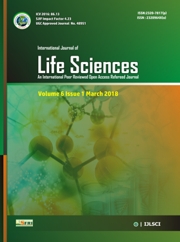RESEARCH ARTICLE
Volume 7 |Issue 6| November-December 2019 First published: 30 December 2019
Distribution of Arbuscular mycorrhizal fungi in Pench forest reserve, (Maharashtra), India
Naqvi Nikhat
Botany Department, SFS College, Seminary Hills, Nagpur (MS), India
E. mail: naqvin@rediffmail.com
Abstract
Keywords:Keywords: Pench, AM fungi, Wastelands, reclamation, trees, phytoremediation
Editor: Dr.Arvind Chavhan
Cite this article as:
Naqvi Nikhat. Distribution of Arbuscular mycorrhizal fungi in Pench forest reserve, (Maharashtra), India, Int. Res. Journal of Science & Engineering, 2019, 7 (6): 167-172.
References
1.Aggangan NS, Anarna JA (2019), Microbial biofertilizers and soil amendments enhanced tree growth and survival in a barren Mined-out area in Marinduque, Philippines, Journal of Environmental Science and Management,22(2): 77-88.
2. Schüßler A, Walker C. (2010), The Glomeromycota: a species list with new families and new genera. The Royal Botanic Garden Edinburgh, The Royal Botanic Garden Kew, Bota¬nische.
3. Gupta MM, .Naqvi NS, Singh VK (2014), The state of arbuscular mycorrhizal fungal diversity in India- an analysis. Sydowia, 66(2):265-288.
4. Gupta MM , Naqvi N , Kumar P. (2017), iAMF-Centralized Database of Arbuscular Mycorrhizal Distribution,Phylogeny and Taxonomy .Journal of Recent Advances in Applied Sciences,30(1):1-5.
5. Smith SE, Read D. J. (2008), Mycorrhizal symbiosis. Academic Press, London.
6. Naqvi N, Naqvi SAMH (2004), Mycorrhiza in management of Fruits and Vegetable diseases In: Diseases of Fruits and Vegetables - Diagnosis and Management, S.A.M.H Naqvi (Ed), Vol II, Kluwer Academic Publishers , Netherlands . pp 537-558.
7. Davison J M, Moora, Öpik M, Adholeya A, Ainsaar L, A.Bâ, Burla S (2015), Global assessment of arbuscular mycorrhizal fungus diversity reveals very low endemism, Science, 349:970-973.
8. Naqvi N (2012), Arbuscular Mycorrhizal (AM) Fungal Biodiversity in Forest of Nagpur(Maharashtra)India. Bionano Frontier, 5(2): 9-11.
9. Naqvi N (2014), Potential of Arbuscular Mycorrhizal (AM) Fungi in Reclamation of Wastelands, International Journal of Life Sciences. Special issue, A2: 48-51.
10. Gerdemann JW, Nicolson TH (1963), Spores of mycorrhizal Endogone sp. extracted from soil by wet sieving and decanting. Trans. Br. Mycol. Soc.,46:235-244.
11. Philips JM, Hayman DS (1970), Improved procedures for clearing roots and staining parasitic and vesicular- arbuscular mycorrhizal fungi for rapid assessment of infection, Trans. Br. Mycol. Soc., 55: 158-161.
12. Oehl F, Laczko E, Bogenrieder A, Stahr K, Boesch R, Heijden M, Sieverding E (2010), Soil type and land use intensity determine the composition of arbuscular mycorrhizal fungal communities, Soil Biology and Biochemistry,42(5):724-738.
13. Martinez TN, Johnson N C (2010), Agrricultural management influences propagule densities and functioning of arbuscular mycorrhizas in low-and high-input agroecosystems in arid environments. Applied Soil Ecology, 46(2):300-306.
14. Gaidashova SV, Van Asten PJA, Jefwa JM, Delvaux B ,Declerck S. (2010), Arbuscular mycorrhizal fungi in the East African Highland banana cropping systems as related to edapho-climatic conditions and management practices :case study of Rwanda .Fungal Ecology,3(3):225-233.

